Unit 1 Business and the Business Environment
VerifiedAdded on 2023/01/11
|15
|5437
|78
AI Summary
Please use the assignment brief from attach and : \n-Plagiarism under 10 % \n- All text should be written in arial size 12 \n- Harvard style reference
Contribute Materials
Your contribution can guide someone’s learning journey. Share your
documents today.
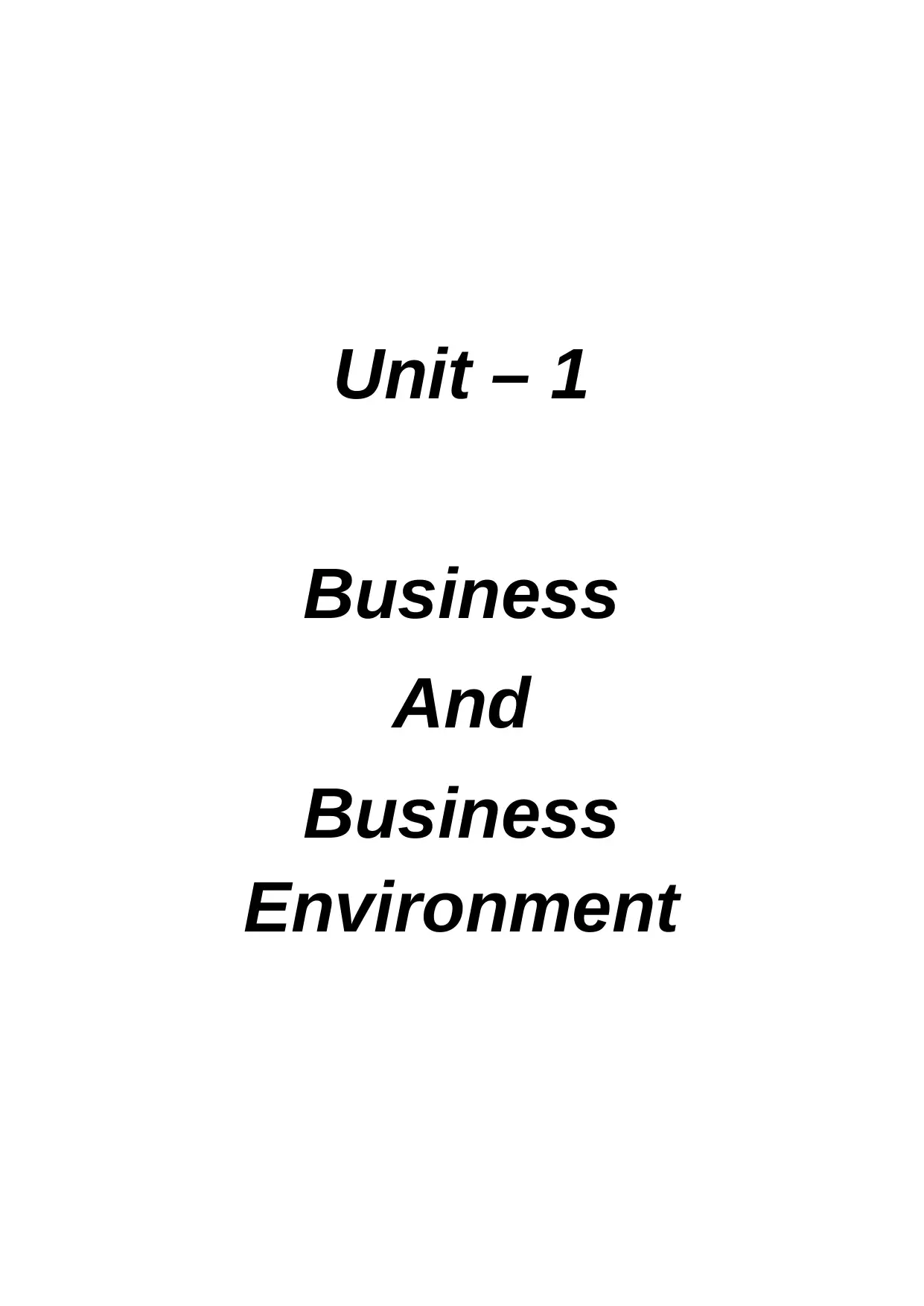
Unit – 1
Business
And
Business
Environment
Business
And
Business
Environment
Secure Best Marks with AI Grader
Need help grading? Try our AI Grader for instant feedback on your assignments.
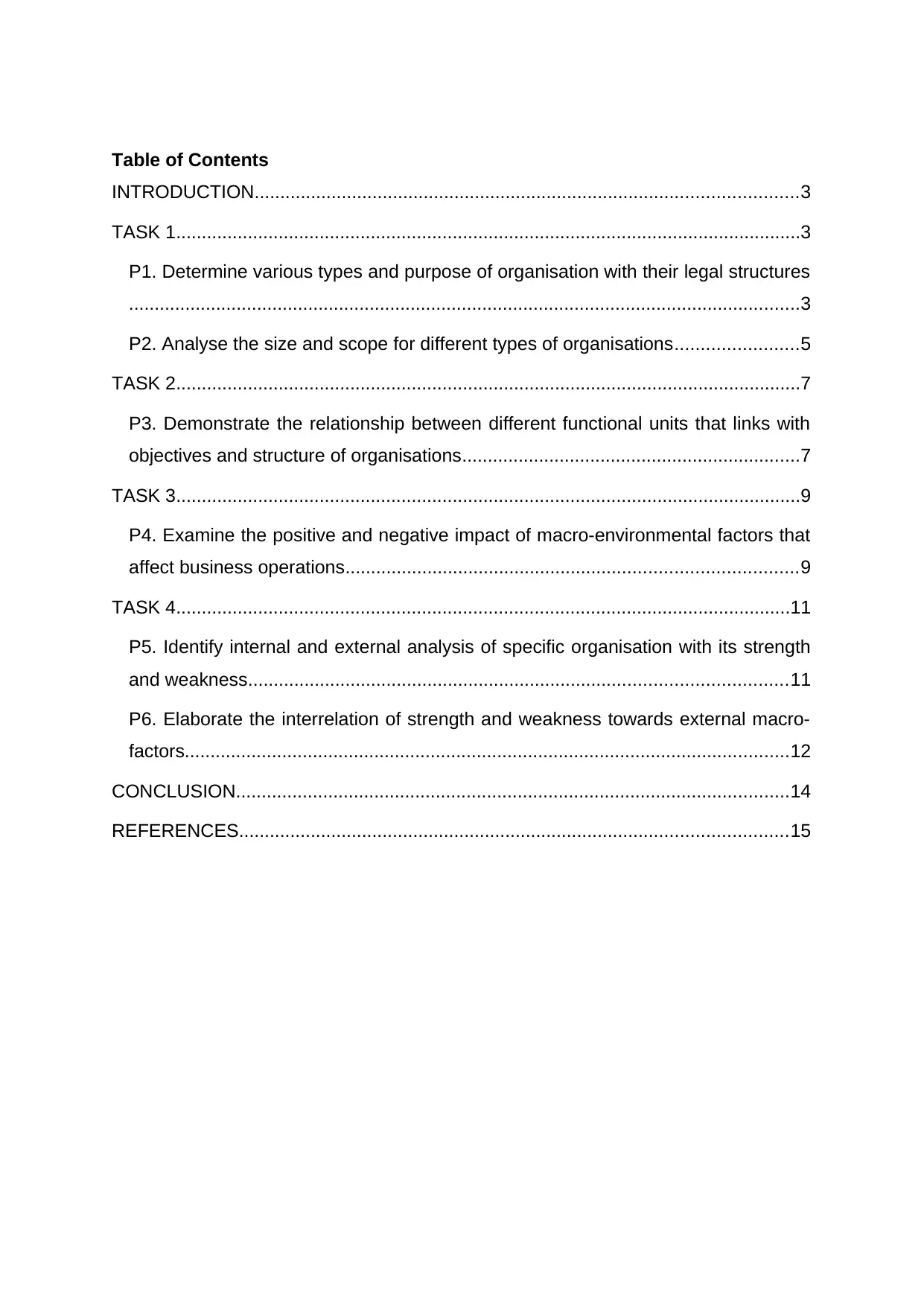
Table of Contents
INTRODUCTION..........................................................................................................3
TASK 1..........................................................................................................................3
P1. Determine various types and purpose of organisation with their legal structures
...................................................................................................................................3
P2. Analyse the size and scope for different types of organisations........................5
TASK 2..........................................................................................................................7
P3. Demonstrate the relationship between different functional units that links with
objectives and structure of organisations..................................................................7
TASK 3..........................................................................................................................9
P4. Examine the positive and negative impact of macro-environmental factors that
affect business operations........................................................................................9
TASK 4........................................................................................................................11
P5. Identify internal and external analysis of specific organisation with its strength
and weakness.........................................................................................................11
P6. Elaborate the interrelation of strength and weakness towards external macro-
factors......................................................................................................................12
CONCLUSION............................................................................................................14
REFERENCES...........................................................................................................15
INTRODUCTION..........................................................................................................3
TASK 1..........................................................................................................................3
P1. Determine various types and purpose of organisation with their legal structures
...................................................................................................................................3
P2. Analyse the size and scope for different types of organisations........................5
TASK 2..........................................................................................................................7
P3. Demonstrate the relationship between different functional units that links with
objectives and structure of organisations..................................................................7
TASK 3..........................................................................................................................9
P4. Examine the positive and negative impact of macro-environmental factors that
affect business operations........................................................................................9
TASK 4........................................................................................................................11
P5. Identify internal and external analysis of specific organisation with its strength
and weakness.........................................................................................................11
P6. Elaborate the interrelation of strength and weakness towards external macro-
factors......................................................................................................................12
CONCLUSION............................................................................................................14
REFERENCES...........................................................................................................15

INTRODUCTION
The business is defined as process through which entrepreneurs and
managers of firm manufactures product for selling it to the target market in order to
maximise revenue and profits. The business environment refers as combination of
internal and external surroundings of company that managers analyse its favourable
and unfavourable impact over an enterprise (Adeoye and Elegunde, 2014). The
organisation selected for this project is Pentland Group as being a privately-owned
global company. It invests in retail and wholesale business for sports fashion sectors
headquartered in London, United Kingdom. This project determines various types
and purpose of organisation with their legal structures. It further analyse the size and
scope for various sectors of business. It demonstrates the relationship between
different functional units that links with objectives and structure of organisations. This
project also examines the positive and negative impact of macro-environmental
factors that affect business operations. Additionally, it identifies internal and external
analysis with its strength and weakness by elaborating the interrelation towards
external macro-factors of business.
TASK 1
P1. Determine various types and purpose of organisation with their legal
structures
Business Environment:- It is described as the ability of managers to analyse
the intrinsic and extrinsic capabilities and weakness as compared to its competitors
for competing them with various strategies. The managers of company mostly
develop strategic decision–making procedure with their innovative idea for being
stable at perfect competition market.
Public Sector:- This sector managers focus on performing its actions by
following the rules and regulations imposed by political leaders. The government of
United Kingdom is mostly stable that is beneficial for company as there is no need
for changing their goals and objectives repeatedly. It is the sector which mainly
focuses on public transportation, education, children welfare infrastructure, military
services, health care, etc. It includes companies such as BBC, British Council,
Environment Agency, British Army, Network Rail, NHS, Automatic Weapons
Establishment (AWE), etc. The main aim of this business is to supply various
services for the benefit of public in domestic country. From the above mentioned
public companies of United Kingdom, the BBC is selected as it stands for British
Broadcasting Corporation as being public service with its headquarters in
Westminster, London (Bah and Fang, 2015).
Purpose:- The main purpose of public sector is to provide various public
service for ease and safe migration of it domestic population. Managers of
The business is defined as process through which entrepreneurs and
managers of firm manufactures product for selling it to the target market in order to
maximise revenue and profits. The business environment refers as combination of
internal and external surroundings of company that managers analyse its favourable
and unfavourable impact over an enterprise (Adeoye and Elegunde, 2014). The
organisation selected for this project is Pentland Group as being a privately-owned
global company. It invests in retail and wholesale business for sports fashion sectors
headquartered in London, United Kingdom. This project determines various types
and purpose of organisation with their legal structures. It further analyse the size and
scope for various sectors of business. It demonstrates the relationship between
different functional units that links with objectives and structure of organisations. This
project also examines the positive and negative impact of macro-environmental
factors that affect business operations. Additionally, it identifies internal and external
analysis with its strength and weakness by elaborating the interrelation towards
external macro-factors of business.
TASK 1
P1. Determine various types and purpose of organisation with their legal
structures
Business Environment:- It is described as the ability of managers to analyse
the intrinsic and extrinsic capabilities and weakness as compared to its competitors
for competing them with various strategies. The managers of company mostly
develop strategic decision–making procedure with their innovative idea for being
stable at perfect competition market.
Public Sector:- This sector managers focus on performing its actions by
following the rules and regulations imposed by political leaders. The government of
United Kingdom is mostly stable that is beneficial for company as there is no need
for changing their goals and objectives repeatedly. It is the sector which mainly
focuses on public transportation, education, children welfare infrastructure, military
services, health care, etc. It includes companies such as BBC, British Council,
Environment Agency, British Army, Network Rail, NHS, Automatic Weapons
Establishment (AWE), etc. The main aim of this business is to supply various
services for the benefit of public in domestic country. From the above mentioned
public companies of United Kingdom, the BBC is selected as it stands for British
Broadcasting Corporation as being public service with its headquarters in
Westminster, London (Bah and Fang, 2015).
Purpose:- The main purpose of public sector is to provide various public
service for ease and safe migration of it domestic population. Managers of
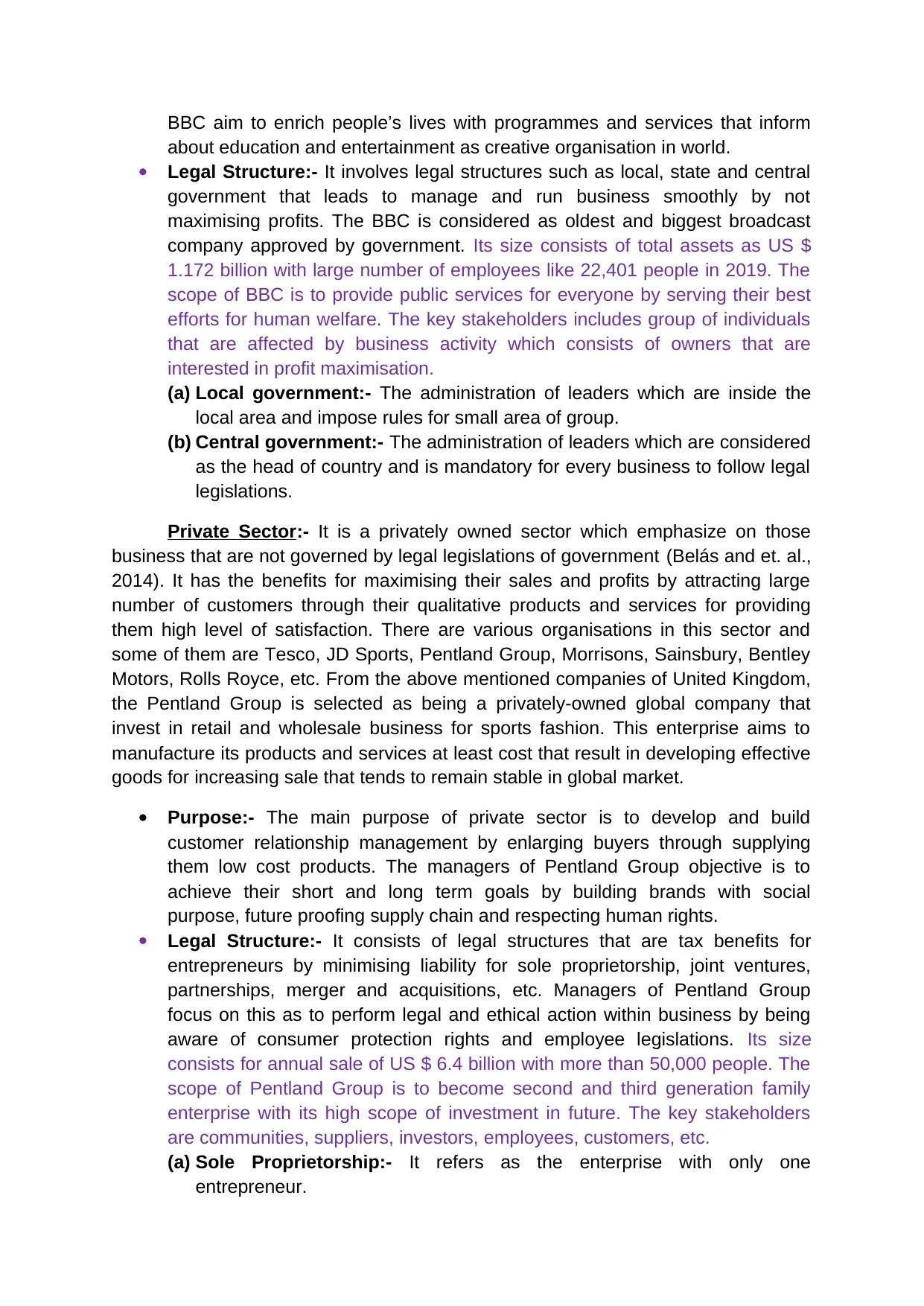
BBC aim to enrich people’s lives with programmes and services that inform
about education and entertainment as creative organisation in world.
Legal Structure:- It involves legal structures such as local, state and central
government that leads to manage and run business smoothly by not
maximising profits. The BBC is considered as oldest and biggest broadcast
company approved by government. Its size consists of total assets as US $
1.172 billion with large number of employees like 22,401 people in 2019. The
scope of BBC is to provide public services for everyone by serving their best
efforts for human welfare. The key stakeholders includes group of individuals
that are affected by business activity which consists of owners that are
interested in profit maximisation.
(a) Local government:- The administration of leaders which are inside the
local area and impose rules for small area of group.
(b) Central government:- The administration of leaders which are considered
as the head of country and is mandatory for every business to follow legal
legislations.
Private Sector:- It is a privately owned sector which emphasize on those
business that are not governed by legal legislations of government (Belás and et. al.,
2014). It has the benefits for maximising their sales and profits by attracting large
number of customers through their qualitative products and services for providing
them high level of satisfaction. There are various organisations in this sector and
some of them are Tesco, JD Sports, Pentland Group, Morrisons, Sainsbury, Bentley
Motors, Rolls Royce, etc. From the above mentioned companies of United Kingdom,
the Pentland Group is selected as being a privately-owned global company that
invest in retail and wholesale business for sports fashion. This enterprise aims to
manufacture its products and services at least cost that result in developing effective
goods for increasing sale that tends to remain stable in global market.
Purpose:- The main purpose of private sector is to develop and build
customer relationship management by enlarging buyers through supplying
them low cost products. The managers of Pentland Group objective is to
achieve their short and long term goals by building brands with social
purpose, future proofing supply chain and respecting human rights.
Legal Structure:- It consists of legal structures that are tax benefits for
entrepreneurs by minimising liability for sole proprietorship, joint ventures,
partnerships, merger and acquisitions, etc. Managers of Pentland Group
focus on this as to perform legal and ethical action within business by being
aware of consumer protection rights and employee legislations. Its size
consists for annual sale of US $ 6.4 billion with more than 50,000 people. The
scope of Pentland Group is to become second and third generation family
enterprise with its high scope of investment in future. The key stakeholders
are communities, suppliers, investors, employees, customers, etc.
(a) Sole Proprietorship:- It refers as the enterprise with only one
entrepreneur.
about education and entertainment as creative organisation in world.
Legal Structure:- It involves legal structures such as local, state and central
government that leads to manage and run business smoothly by not
maximising profits. The BBC is considered as oldest and biggest broadcast
company approved by government. Its size consists of total assets as US $
1.172 billion with large number of employees like 22,401 people in 2019. The
scope of BBC is to provide public services for everyone by serving their best
efforts for human welfare. The key stakeholders includes group of individuals
that are affected by business activity which consists of owners that are
interested in profit maximisation.
(a) Local government:- The administration of leaders which are inside the
local area and impose rules for small area of group.
(b) Central government:- The administration of leaders which are considered
as the head of country and is mandatory for every business to follow legal
legislations.
Private Sector:- It is a privately owned sector which emphasize on those
business that are not governed by legal legislations of government (Belás and et. al.,
2014). It has the benefits for maximising their sales and profits by attracting large
number of customers through their qualitative products and services for providing
them high level of satisfaction. There are various organisations in this sector and
some of them are Tesco, JD Sports, Pentland Group, Morrisons, Sainsbury, Bentley
Motors, Rolls Royce, etc. From the above mentioned companies of United Kingdom,
the Pentland Group is selected as being a privately-owned global company that
invest in retail and wholesale business for sports fashion. This enterprise aims to
manufacture its products and services at least cost that result in developing effective
goods for increasing sale that tends to remain stable in global market.
Purpose:- The main purpose of private sector is to develop and build
customer relationship management by enlarging buyers through supplying
them low cost products. The managers of Pentland Group objective is to
achieve their short and long term goals by building brands with social
purpose, future proofing supply chain and respecting human rights.
Legal Structure:- It consists of legal structures that are tax benefits for
entrepreneurs by minimising liability for sole proprietorship, joint ventures,
partnerships, merger and acquisitions, etc. Managers of Pentland Group
focus on this as to perform legal and ethical action within business by being
aware of consumer protection rights and employee legislations. Its size
consists for annual sale of US $ 6.4 billion with more than 50,000 people. The
scope of Pentland Group is to become second and third generation family
enterprise with its high scope of investment in future. The key stakeholders
are communities, suppliers, investors, employees, customers, etc.
(a) Sole Proprietorship:- It refers as the enterprise with only one
entrepreneur.
Secure Best Marks with AI Grader
Need help grading? Try our AI Grader for instant feedback on your assignments.

(b) Partnership:- It refers as the enterprise with two or more than two
entrepreneurs in an organisation.
Voluntary Sector:- This sector is mostly termed as non-governmental
enterprise with its main objective is to perform actions for social welfare. This
provides services such as save the children international, National Trust, Oxfam,
National council for voluntary organisation (NCVO), etc., that works for charity and
society welfare (Buğra and Savaşkan, 2016). From the above mentioned companies
of United Kingdom, the Oxfam International has been selected as being a
confederation of 19 independent charitable organisations focusing on the poverty.
Purpose:- The purpose of voluntary sector is to provide services through
social welfare for society and create job opportunity for restricting
unemployment rate. Managers of Oxfam claims for right of better life to poor
people by saving their lives with food supplies and increasing monetary terms.
Legal Structure:- It includes legal structures such as charitable transactions
and non-profit actions. The legal structure for managers of Oxfam is to
provide charity for public welfare to survive their lives happily within the
country. Its size consists of 1,200 shops worldwide supplying books, music,
furniture and bridal wear. The scope of Oxfam is to challenge the inequalities
among rural and urban areas which usually keep aside poor people. The key
stakeholders are individual and communities, partners and allies, donors and
supporters, staff and the wide public, etc.
(a) Charitable transactions:- The main aim of this sector is to provide charity
and welfare for making poor people to survive their livelihood by having
two time meals a day.
(b) Non-profit actions:- The objective of this sector is not to maximise profits
but facilitate services for below poverty line members (Enofe and et. al.,
2013).
P2. Analyse the size and scope for different types of organisations
The vision, mission, size and scope of various organisation have been
described for three sectors such as Public (British Broadcast Company), Private
(Pentland Group) and Voluntary (Oxfam).
Public Sector (British Broadcast Company) - BBC:-
Features Explanation
Vision The vision of BBC is to act as the most creative organisation
in the world. It is evident that the BBC is not simply satisfied
with dominating in United Kingdom.
Mission The mission of BBC is to act in public interest, serving all
audiences through the provision of impartial, high-quality and
distinctive output and services which inform, educate and
entertain.
Objectives The main purpose of BBC is to enrich people’s lives with
programmes and services that inform, educate and entertain
entrepreneurs in an organisation.
Voluntary Sector:- This sector is mostly termed as non-governmental
enterprise with its main objective is to perform actions for social welfare. This
provides services such as save the children international, National Trust, Oxfam,
National council for voluntary organisation (NCVO), etc., that works for charity and
society welfare (Buğra and Savaşkan, 2016). From the above mentioned companies
of United Kingdom, the Oxfam International has been selected as being a
confederation of 19 independent charitable organisations focusing on the poverty.
Purpose:- The purpose of voluntary sector is to provide services through
social welfare for society and create job opportunity for restricting
unemployment rate. Managers of Oxfam claims for right of better life to poor
people by saving their lives with food supplies and increasing monetary terms.
Legal Structure:- It includes legal structures such as charitable transactions
and non-profit actions. The legal structure for managers of Oxfam is to
provide charity for public welfare to survive their lives happily within the
country. Its size consists of 1,200 shops worldwide supplying books, music,
furniture and bridal wear. The scope of Oxfam is to challenge the inequalities
among rural and urban areas which usually keep aside poor people. The key
stakeholders are individual and communities, partners and allies, donors and
supporters, staff and the wide public, etc.
(a) Charitable transactions:- The main aim of this sector is to provide charity
and welfare for making poor people to survive their livelihood by having
two time meals a day.
(b) Non-profit actions:- The objective of this sector is not to maximise profits
but facilitate services for below poverty line members (Enofe and et. al.,
2013).
P2. Analyse the size and scope for different types of organisations
The vision, mission, size and scope of various organisation have been
described for three sectors such as Public (British Broadcast Company), Private
(Pentland Group) and Voluntary (Oxfam).
Public Sector (British Broadcast Company) - BBC:-
Features Explanation
Vision The vision of BBC is to act as the most creative organisation
in the world. It is evident that the BBC is not simply satisfied
with dominating in United Kingdom.
Mission The mission of BBC is to act in public interest, serving all
audiences through the provision of impartial, high-quality and
distinctive output and services which inform, educate and
entertain.
Objectives The main purpose of BBC is to enrich people’s lives with
programmes and services that inform, educate and entertain
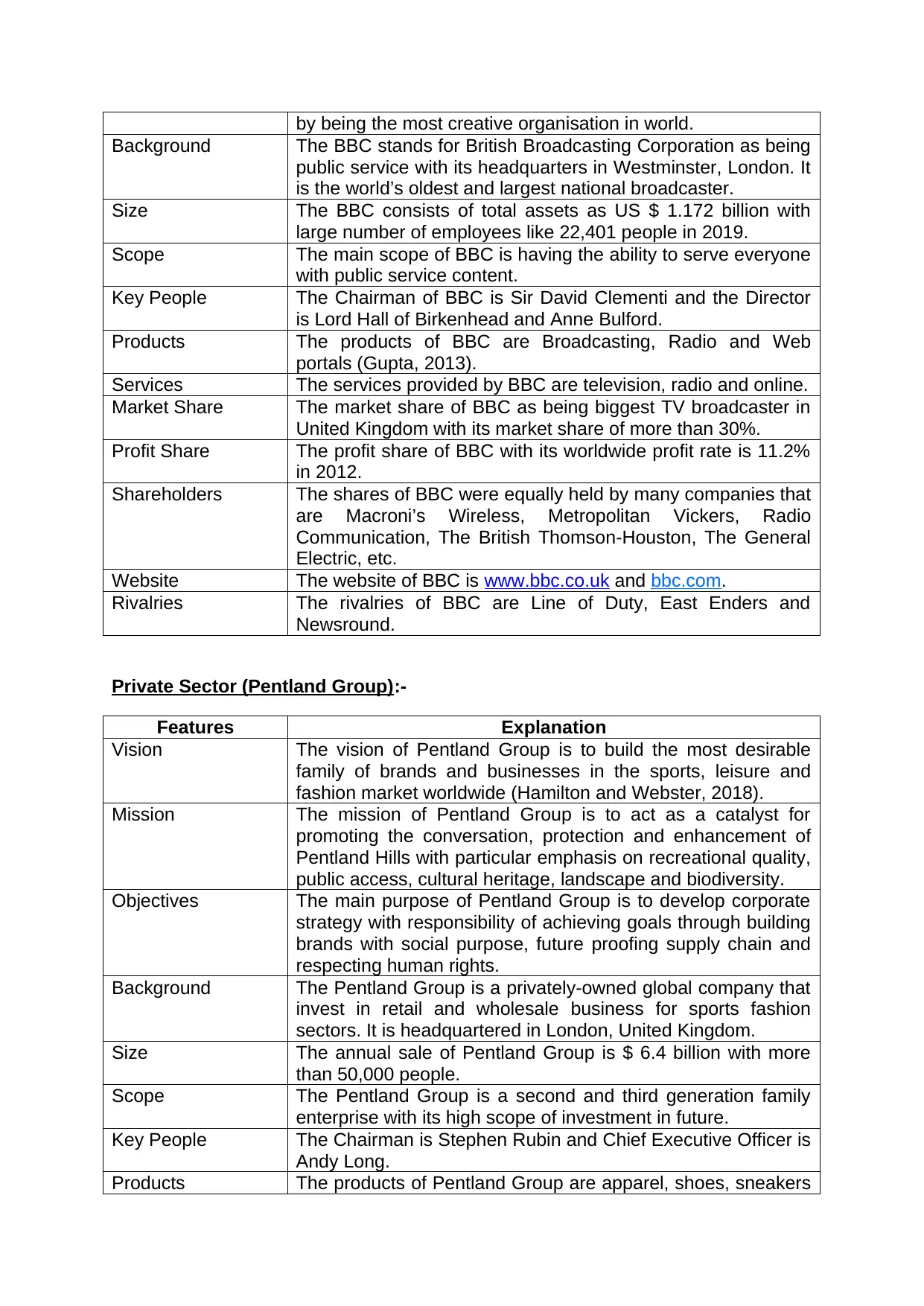
by being the most creative organisation in world.
Background The BBC stands for British Broadcasting Corporation as being
public service with its headquarters in Westminster, London. It
is the world’s oldest and largest national broadcaster.
Size The BBC consists of total assets as US $ 1.172 billion with
large number of employees like 22,401 people in 2019.
Scope The main scope of BBC is having the ability to serve everyone
with public service content.
Key People The Chairman of BBC is Sir David Clementi and the Director
is Lord Hall of Birkenhead and Anne Bulford.
Products The products of BBC are Broadcasting, Radio and Web
portals (Gupta, 2013).
Services The services provided by BBC are television, radio and online.
Market Share The market share of BBC as being biggest TV broadcaster in
United Kingdom with its market share of more than 30%.
Profit Share The profit share of BBC with its worldwide profit rate is 11.2%
in 2012.
Shareholders The shares of BBC were equally held by many companies that
are Macroni’s Wireless, Metropolitan Vickers, Radio
Communication, The British Thomson-Houston, The General
Electric, etc.
Website The website of BBC is www.bbc.co.uk and bbc.com.
Rivalries The rivalries of BBC are Line of Duty, East Enders and
Newsround.
Private Sector (Pentland Group):-
Features Explanation
Vision The vision of Pentland Group is to build the most desirable
family of brands and businesses in the sports, leisure and
fashion market worldwide (Hamilton and Webster, 2018).
Mission The mission of Pentland Group is to act as a catalyst for
promoting the conversation, protection and enhancement of
Pentland Hills with particular emphasis on recreational quality,
public access, cultural heritage, landscape and biodiversity.
Objectives The main purpose of Pentland Group is to develop corporate
strategy with responsibility of achieving goals through building
brands with social purpose, future proofing supply chain and
respecting human rights.
Background The Pentland Group is a privately-owned global company that
invest in retail and wholesale business for sports fashion
sectors. It is headquartered in London, United Kingdom.
Size The annual sale of Pentland Group is $ 6.4 billion with more
than 50,000 people.
Scope The Pentland Group is a second and third generation family
enterprise with its high scope of investment in future.
Key People The Chairman is Stephen Rubin and Chief Executive Officer is
Andy Long.
Products The products of Pentland Group are apparel, shoes, sneakers
Background The BBC stands for British Broadcasting Corporation as being
public service with its headquarters in Westminster, London. It
is the world’s oldest and largest national broadcaster.
Size The BBC consists of total assets as US $ 1.172 billion with
large number of employees like 22,401 people in 2019.
Scope The main scope of BBC is having the ability to serve everyone
with public service content.
Key People The Chairman of BBC is Sir David Clementi and the Director
is Lord Hall of Birkenhead and Anne Bulford.
Products The products of BBC are Broadcasting, Radio and Web
portals (Gupta, 2013).
Services The services provided by BBC are television, radio and online.
Market Share The market share of BBC as being biggest TV broadcaster in
United Kingdom with its market share of more than 30%.
Profit Share The profit share of BBC with its worldwide profit rate is 11.2%
in 2012.
Shareholders The shares of BBC were equally held by many companies that
are Macroni’s Wireless, Metropolitan Vickers, Radio
Communication, The British Thomson-Houston, The General
Electric, etc.
Website The website of BBC is www.bbc.co.uk and bbc.com.
Rivalries The rivalries of BBC are Line of Duty, East Enders and
Newsround.
Private Sector (Pentland Group):-
Features Explanation
Vision The vision of Pentland Group is to build the most desirable
family of brands and businesses in the sports, leisure and
fashion market worldwide (Hamilton and Webster, 2018).
Mission The mission of Pentland Group is to act as a catalyst for
promoting the conversation, protection and enhancement of
Pentland Hills with particular emphasis on recreational quality,
public access, cultural heritage, landscape and biodiversity.
Objectives The main purpose of Pentland Group is to develop corporate
strategy with responsibility of achieving goals through building
brands with social purpose, future proofing supply chain and
respecting human rights.
Background The Pentland Group is a privately-owned global company that
invest in retail and wholesale business for sports fashion
sectors. It is headquartered in London, United Kingdom.
Size The annual sale of Pentland Group is $ 6.4 billion with more
than 50,000 people.
Scope The Pentland Group is a second and third generation family
enterprise with its high scope of investment in future.
Key People The Chairman is Stephen Rubin and Chief Executive Officer is
Andy Long.
Products The products of Pentland Group are apparel, shoes, sneakers
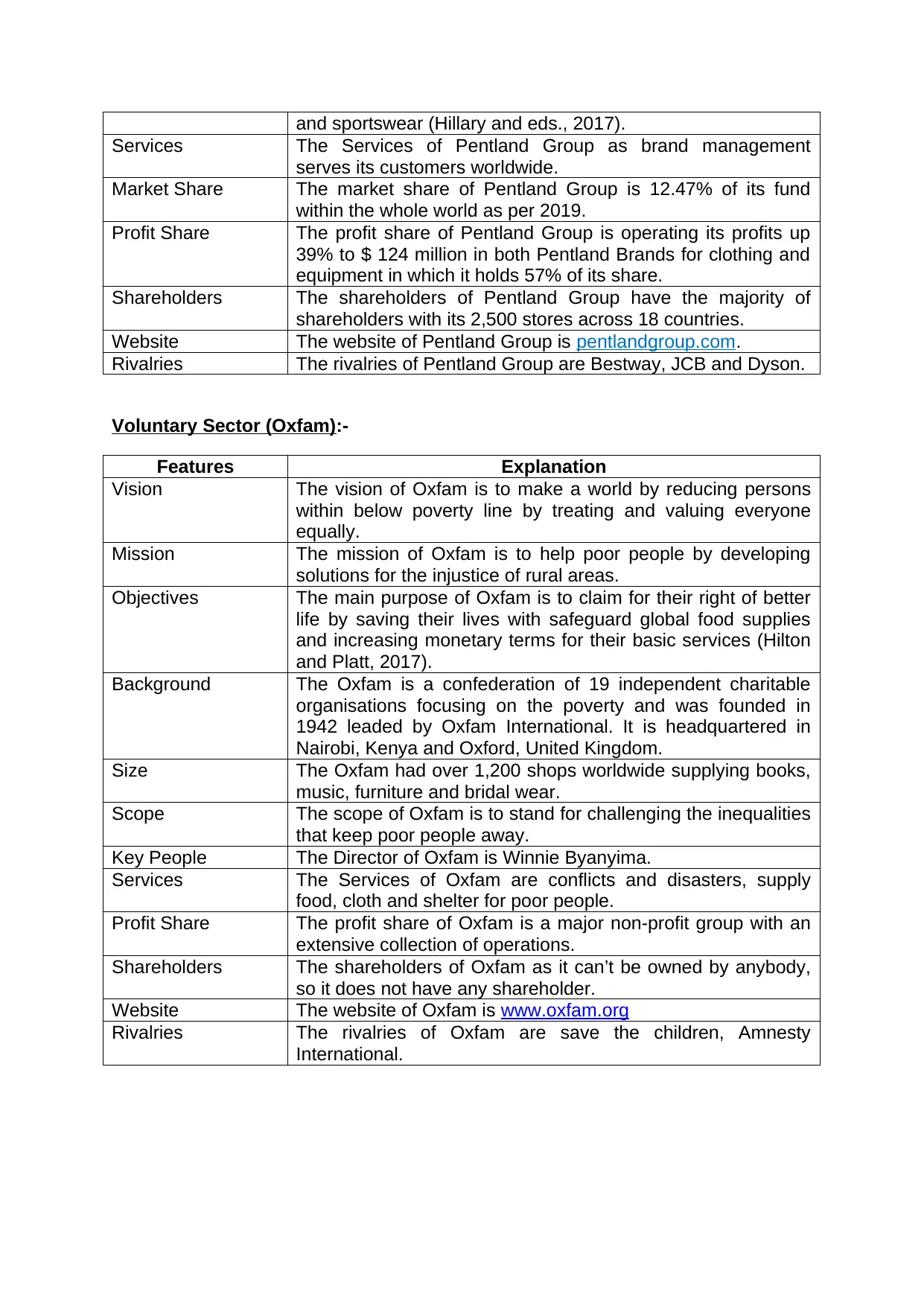
and sportswear (Hillary and eds., 2017).
Services The Services of Pentland Group as brand management
serves its customers worldwide.
Market Share The market share of Pentland Group is 12.47% of its fund
within the whole world as per 2019.
Profit Share The profit share of Pentland Group is operating its profits up
39% to $ 124 million in both Pentland Brands for clothing and
equipment in which it holds 57% of its share.
Shareholders The shareholders of Pentland Group have the majority of
shareholders with its 2,500 stores across 18 countries.
Website The website of Pentland Group is pentlandgroup.com.
Rivalries The rivalries of Pentland Group are Bestway, JCB and Dyson.
Voluntary Sector (Oxfam):-
Features Explanation
Vision The vision of Oxfam is to make a world by reducing persons
within below poverty line by treating and valuing everyone
equally.
Mission The mission of Oxfam is to help poor people by developing
solutions for the injustice of rural areas.
Objectives The main purpose of Oxfam is to claim for their right of better
life by saving their lives with safeguard global food supplies
and increasing monetary terms for their basic services (Hilton
and Platt, 2017).
Background The Oxfam is a confederation of 19 independent charitable
organisations focusing on the poverty and was founded in
1942 leaded by Oxfam International. It is headquartered in
Nairobi, Kenya and Oxford, United Kingdom.
Size The Oxfam had over 1,200 shops worldwide supplying books,
music, furniture and bridal wear.
Scope The scope of Oxfam is to stand for challenging the inequalities
that keep poor people away.
Key People The Director of Oxfam is Winnie Byanyima.
Services The Services of Oxfam are conflicts and disasters, supply
food, cloth and shelter for poor people.
Profit Share The profit share of Oxfam is a major non-profit group with an
extensive collection of operations.
Shareholders The shareholders of Oxfam as it can’t be owned by anybody,
so it does not have any shareholder.
Website The website of Oxfam is www.oxfam.org
Rivalries The rivalries of Oxfam are save the children, Amnesty
International.
Services The Services of Pentland Group as brand management
serves its customers worldwide.
Market Share The market share of Pentland Group is 12.47% of its fund
within the whole world as per 2019.
Profit Share The profit share of Pentland Group is operating its profits up
39% to $ 124 million in both Pentland Brands for clothing and
equipment in which it holds 57% of its share.
Shareholders The shareholders of Pentland Group have the majority of
shareholders with its 2,500 stores across 18 countries.
Website The website of Pentland Group is pentlandgroup.com.
Rivalries The rivalries of Pentland Group are Bestway, JCB and Dyson.
Voluntary Sector (Oxfam):-
Features Explanation
Vision The vision of Oxfam is to make a world by reducing persons
within below poverty line by treating and valuing everyone
equally.
Mission The mission of Oxfam is to help poor people by developing
solutions for the injustice of rural areas.
Objectives The main purpose of Oxfam is to claim for their right of better
life by saving their lives with safeguard global food supplies
and increasing monetary terms for their basic services (Hilton
and Platt, 2017).
Background The Oxfam is a confederation of 19 independent charitable
organisations focusing on the poverty and was founded in
1942 leaded by Oxfam International. It is headquartered in
Nairobi, Kenya and Oxford, United Kingdom.
Size The Oxfam had over 1,200 shops worldwide supplying books,
music, furniture and bridal wear.
Scope The scope of Oxfam is to stand for challenging the inequalities
that keep poor people away.
Key People The Director of Oxfam is Winnie Byanyima.
Services The Services of Oxfam are conflicts and disasters, supply
food, cloth and shelter for poor people.
Profit Share The profit share of Oxfam is a major non-profit group with an
extensive collection of operations.
Shareholders The shareholders of Oxfam as it can’t be owned by anybody,
so it does not have any shareholder.
Website The website of Oxfam is www.oxfam.org
Rivalries The rivalries of Oxfam are save the children, Amnesty
International.
Paraphrase This Document
Need a fresh take? Get an instant paraphrase of this document with our AI Paraphraser

TASK 2
P3. Demonstrate the relationship between different functional units that links
with objectives and structure of organisations
Organisational Structure:- It refers as the activities of workforce been
performed within an organisation for completing its target at particular duration. The
managers of Pentland Group focus monitor and control the actions of workers by
identifying errors and develops various strategies to minimise it through corrective
measures (Kljucnikov and et. al., 2016).
Functional Structure:- The managers of Pentland Group can use this
functional structure for delegating their activities by discriminating to workers
in accordance with their capability.
(a) Advantages:- The managers of Pentland Group are highly advantageous
as they are able to perform their business actions in particular scenario.
This is beneficial for company to develop its aggressive strategies through
good interpersonal relations which leads to accomplish target at time.
(b) Disadvantages:- Pentland Group managers face challenge within this
structure as people are expertise in their particular field and does not have
knowledge or experience of different work. This creates delay for goal
accomplishment as vacant are not fulfilled easily which creates more time
consumption for achieving success.
Divisional Structure:- Managers of Pentland Group can use this structure as
to segregate the roles and responsibilities of business into various
departments such as finance, HRM, marketing, sales, etc., for empowering
them to complete target at specified date.
(a) Advantages:- The managers of Pentland Group are profitable in this
structure by following delegation of authority that results in improving their
skills and proficiency for the particular work.
(b) Disadvantages:- Pentland Group managers are unhelpful as divisional
structure creates challenge for business through creating work burden on
employees that lacks in motivation.
From the above discussed various types of organisational structure,
managers of Pentland Group mostly adopts divisional structure for distributing
activities into departments. It further results in specialisation and leads to achieve
goals and objectives of business efficiently for sustaining in global market.
The relationship between different functional units that links with
objectives and structure of Pentland Group is as follows:-
Finance with HRM:- The finance manager collaborate with Human resource
department as to ascertain the task performed by workers is mostly done as
per their estimated plan. It further leads to balance the expected and actual
budget with their revenue and expenditure of business (Maresova and
Klimova, 2015).
P3. Demonstrate the relationship between different functional units that links
with objectives and structure of organisations
Organisational Structure:- It refers as the activities of workforce been
performed within an organisation for completing its target at particular duration. The
managers of Pentland Group focus monitor and control the actions of workers by
identifying errors and develops various strategies to minimise it through corrective
measures (Kljucnikov and et. al., 2016).
Functional Structure:- The managers of Pentland Group can use this
functional structure for delegating their activities by discriminating to workers
in accordance with their capability.
(a) Advantages:- The managers of Pentland Group are highly advantageous
as they are able to perform their business actions in particular scenario.
This is beneficial for company to develop its aggressive strategies through
good interpersonal relations which leads to accomplish target at time.
(b) Disadvantages:- Pentland Group managers face challenge within this
structure as people are expertise in their particular field and does not have
knowledge or experience of different work. This creates delay for goal
accomplishment as vacant are not fulfilled easily which creates more time
consumption for achieving success.
Divisional Structure:- Managers of Pentland Group can use this structure as
to segregate the roles and responsibilities of business into various
departments such as finance, HRM, marketing, sales, etc., for empowering
them to complete target at specified date.
(a) Advantages:- The managers of Pentland Group are profitable in this
structure by following delegation of authority that results in improving their
skills and proficiency for the particular work.
(b) Disadvantages:- Pentland Group managers are unhelpful as divisional
structure creates challenge for business through creating work burden on
employees that lacks in motivation.
From the above discussed various types of organisational structure,
managers of Pentland Group mostly adopts divisional structure for distributing
activities into departments. It further results in specialisation and leads to achieve
goals and objectives of business efficiently for sustaining in global market.
The relationship between different functional units that links with
objectives and structure of Pentland Group is as follows:-
Finance with HRM:- The finance manager collaborate with Human resource
department as to ascertain the task performed by workers is mostly done as
per their estimated plan. It further leads to balance the expected and actual
budget with their revenue and expenditure of business (Maresova and
Klimova, 2015).
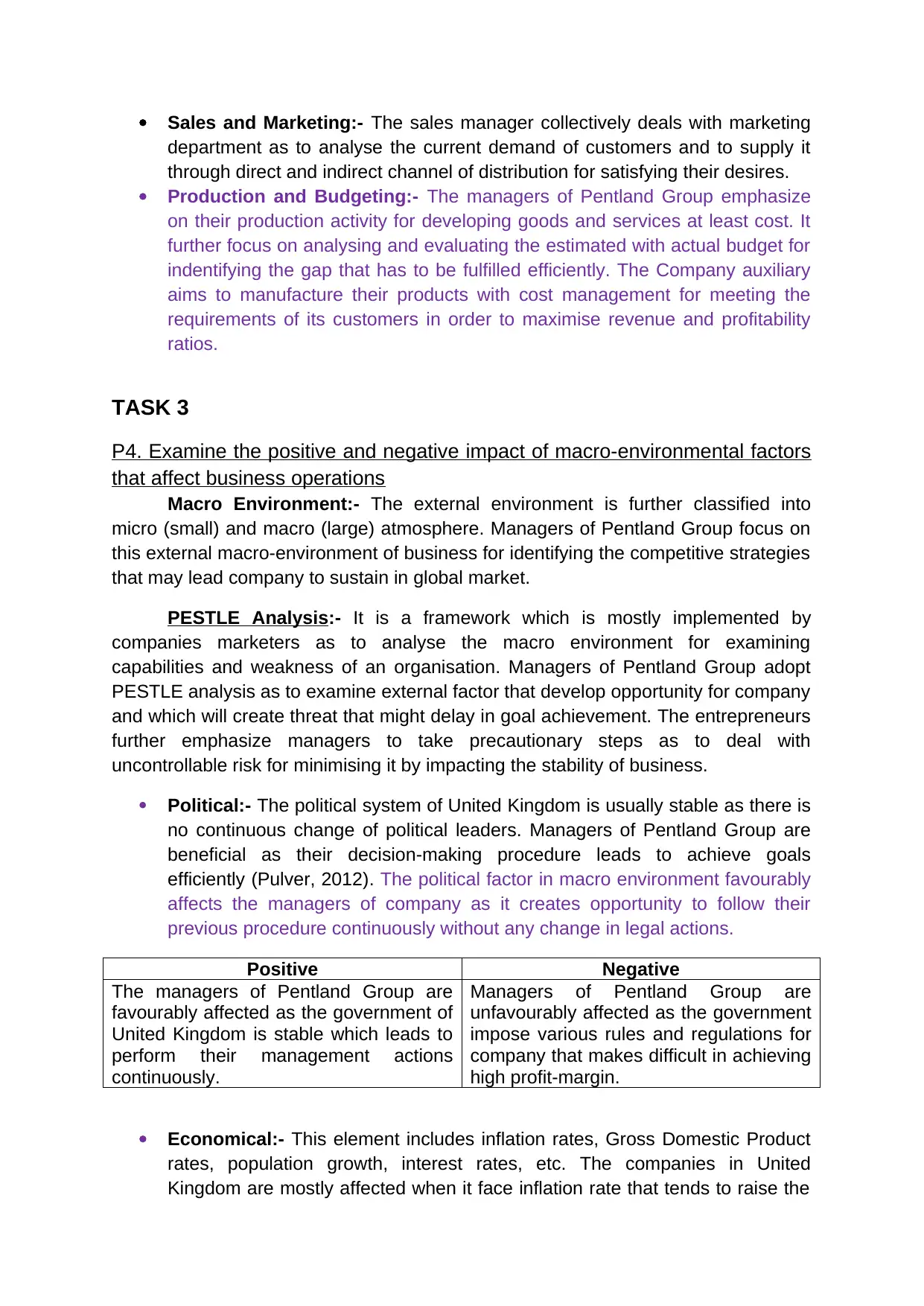
Sales and Marketing:- The sales manager collectively deals with marketing
department as to analyse the current demand of customers and to supply it
through direct and indirect channel of distribution for satisfying their desires.
Production and Budgeting:- The managers of Pentland Group emphasize
on their production activity for developing goods and services at least cost. It
further focus on analysing and evaluating the estimated with actual budget for
indentifying the gap that has to be fulfilled efficiently. The Company auxiliary
aims to manufacture their products with cost management for meeting the
requirements of its customers in order to maximise revenue and profitability
ratios.
TASK 3
P4. Examine the positive and negative impact of macro-environmental factors
that affect business operations
Macro Environment:- The external environment is further classified into
micro (small) and macro (large) atmosphere. Managers of Pentland Group focus on
this external macro-environment of business for identifying the competitive strategies
that may lead company to sustain in global market.
PESTLE Analysis:- It is a framework which is mostly implemented by
companies marketers as to analyse the macro environment for examining
capabilities and weakness of an organisation. Managers of Pentland Group adopt
PESTLE analysis as to examine external factor that develop opportunity for company
and which will create threat that might delay in goal achievement. The entrepreneurs
further emphasize managers to take precautionary steps as to deal with
uncontrollable risk for minimising it by impacting the stability of business.
Political:- The political system of United Kingdom is usually stable as there is
no continuous change of political leaders. Managers of Pentland Group are
beneficial as their decision-making procedure leads to achieve goals
efficiently (Pulver, 2012). The political factor in macro environment favourably
affects the managers of company as it creates opportunity to follow their
previous procedure continuously without any change in legal actions.
Positive Negative
The managers of Pentland Group are
favourably affected as the government of
United Kingdom is stable which leads to
perform their management actions
continuously.
Managers of Pentland Group are
unfavourably affected as the government
impose various rules and regulations for
company that makes difficult in achieving
high profit-margin.
Economical:- This element includes inflation rates, Gross Domestic Product
rates, population growth, interest rates, etc. The companies in United
Kingdom are mostly affected when it face inflation rate that tends to raise the
department as to analyse the current demand of customers and to supply it
through direct and indirect channel of distribution for satisfying their desires.
Production and Budgeting:- The managers of Pentland Group emphasize
on their production activity for developing goods and services at least cost. It
further focus on analysing and evaluating the estimated with actual budget for
indentifying the gap that has to be fulfilled efficiently. The Company auxiliary
aims to manufacture their products with cost management for meeting the
requirements of its customers in order to maximise revenue and profitability
ratios.
TASK 3
P4. Examine the positive and negative impact of macro-environmental factors
that affect business operations
Macro Environment:- The external environment is further classified into
micro (small) and macro (large) atmosphere. Managers of Pentland Group focus on
this external macro-environment of business for identifying the competitive strategies
that may lead company to sustain in global market.
PESTLE Analysis:- It is a framework which is mostly implemented by
companies marketers as to analyse the macro environment for examining
capabilities and weakness of an organisation. Managers of Pentland Group adopt
PESTLE analysis as to examine external factor that develop opportunity for company
and which will create threat that might delay in goal achievement. The entrepreneurs
further emphasize managers to take precautionary steps as to deal with
uncontrollable risk for minimising it by impacting the stability of business.
Political:- The political system of United Kingdom is usually stable as there is
no continuous change of political leaders. Managers of Pentland Group are
beneficial as their decision-making procedure leads to achieve goals
efficiently (Pulver, 2012). The political factor in macro environment favourably
affects the managers of company as it creates opportunity to follow their
previous procedure continuously without any change in legal actions.
Positive Negative
The managers of Pentland Group are
favourably affected as the government of
United Kingdom is stable which leads to
perform their management actions
continuously.
Managers of Pentland Group are
unfavourably affected as the government
impose various rules and regulations for
company that makes difficult in achieving
high profit-margin.
Economical:- This element includes inflation rates, Gross Domestic Product
rates, population growth, interest rates, etc. The companies in United
Kingdom are mostly affected when it face inflation rate that tends to raise the
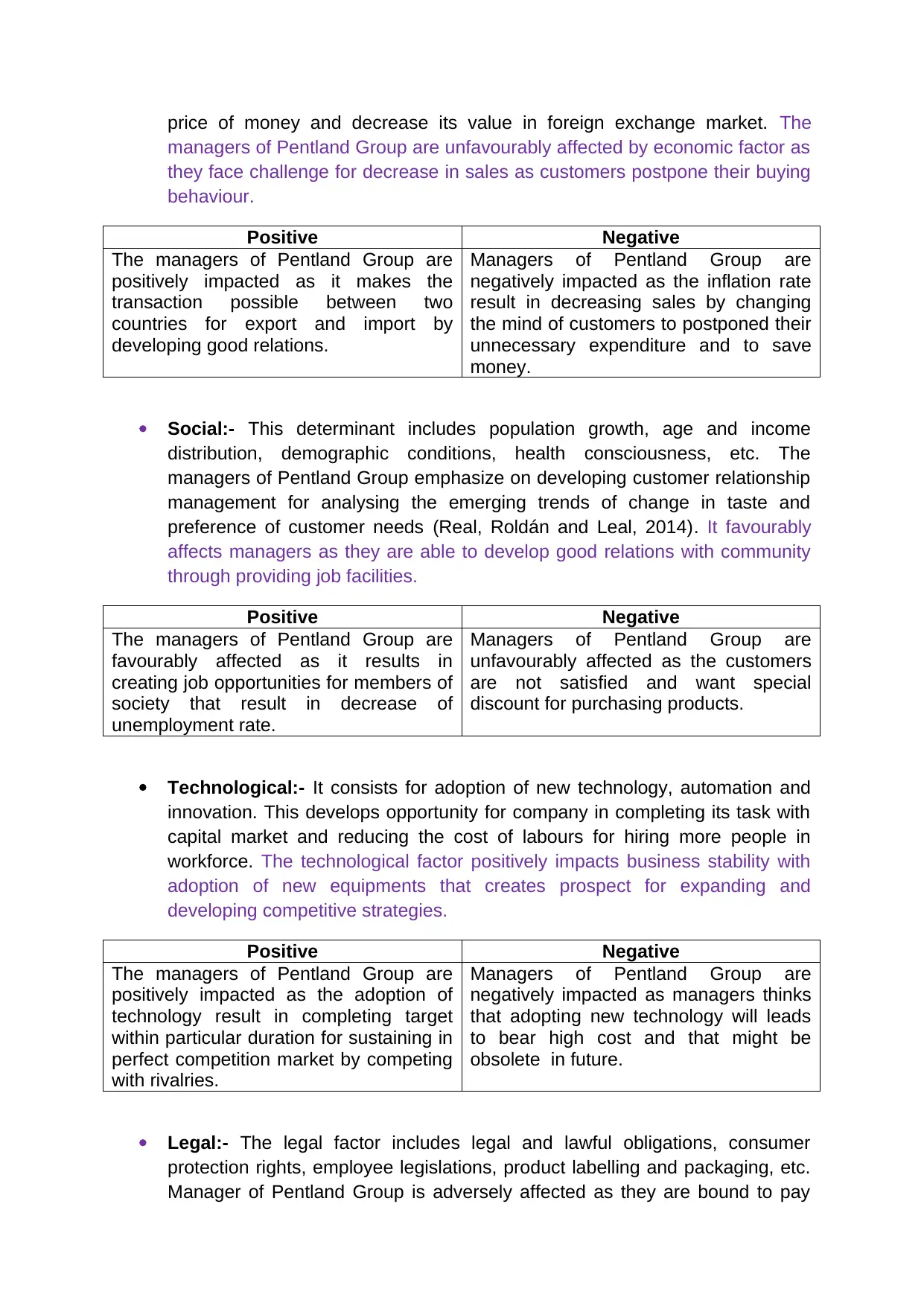
price of money and decrease its value in foreign exchange market. The
managers of Pentland Group are unfavourably affected by economic factor as
they face challenge for decrease in sales as customers postpone their buying
behaviour.
Positive Negative
The managers of Pentland Group are
positively impacted as it makes the
transaction possible between two
countries for export and import by
developing good relations.
Managers of Pentland Group are
negatively impacted as the inflation rate
result in decreasing sales by changing
the mind of customers to postponed their
unnecessary expenditure and to save
money.
Social:- This determinant includes population growth, age and income
distribution, demographic conditions, health consciousness, etc. The
managers of Pentland Group emphasize on developing customer relationship
management for analysing the emerging trends of change in taste and
preference of customer needs (Real, Roldán and Leal, 2014). It favourably
affects managers as they are able to develop good relations with community
through providing job facilities.
Positive Negative
The managers of Pentland Group are
favourably affected as it results in
creating job opportunities for members of
society that result in decrease of
unemployment rate.
Managers of Pentland Group are
unfavourably affected as the customers
are not satisfied and want special
discount for purchasing products.
Technological:- It consists for adoption of new technology, automation and
innovation. This develops opportunity for company in completing its task with
capital market and reducing the cost of labours for hiring more people in
workforce. The technological factor positively impacts business stability with
adoption of new equipments that creates prospect for expanding and
developing competitive strategies.
Positive Negative
The managers of Pentland Group are
positively impacted as the adoption of
technology result in completing target
within particular duration for sustaining in
perfect competition market by competing
with rivalries.
Managers of Pentland Group are
negatively impacted as managers thinks
that adopting new technology will leads
to bear high cost and that might be
obsolete in future.
Legal:- The legal factor includes legal and lawful obligations, consumer
protection rights, employee legislations, product labelling and packaging, etc.
Manager of Pentland Group is adversely affected as they are bound to pay
managers of Pentland Group are unfavourably affected by economic factor as
they face challenge for decrease in sales as customers postpone their buying
behaviour.
Positive Negative
The managers of Pentland Group are
positively impacted as it makes the
transaction possible between two
countries for export and import by
developing good relations.
Managers of Pentland Group are
negatively impacted as the inflation rate
result in decreasing sales by changing
the mind of customers to postponed their
unnecessary expenditure and to save
money.
Social:- This determinant includes population growth, age and income
distribution, demographic conditions, health consciousness, etc. The
managers of Pentland Group emphasize on developing customer relationship
management for analysing the emerging trends of change in taste and
preference of customer needs (Real, Roldán and Leal, 2014). It favourably
affects managers as they are able to develop good relations with community
through providing job facilities.
Positive Negative
The managers of Pentland Group are
favourably affected as it results in
creating job opportunities for members of
society that result in decrease of
unemployment rate.
Managers of Pentland Group are
unfavourably affected as the customers
are not satisfied and want special
discount for purchasing products.
Technological:- It consists for adoption of new technology, automation and
innovation. This develops opportunity for company in completing its task with
capital market and reducing the cost of labours for hiring more people in
workforce. The technological factor positively impacts business stability with
adoption of new equipments that creates prospect for expanding and
developing competitive strategies.
Positive Negative
The managers of Pentland Group are
positively impacted as the adoption of
technology result in completing target
within particular duration for sustaining in
perfect competition market by competing
with rivalries.
Managers of Pentland Group are
negatively impacted as managers thinks
that adopting new technology will leads
to bear high cost and that might be
obsolete in future.
Legal:- The legal factor includes legal and lawful obligations, consumer
protection rights, employee legislations, product labelling and packaging, etc.
Manager of Pentland Group is adversely affected as they are bound to pay
Secure Best Marks with AI Grader
Need help grading? Try our AI Grader for instant feedback on your assignments.
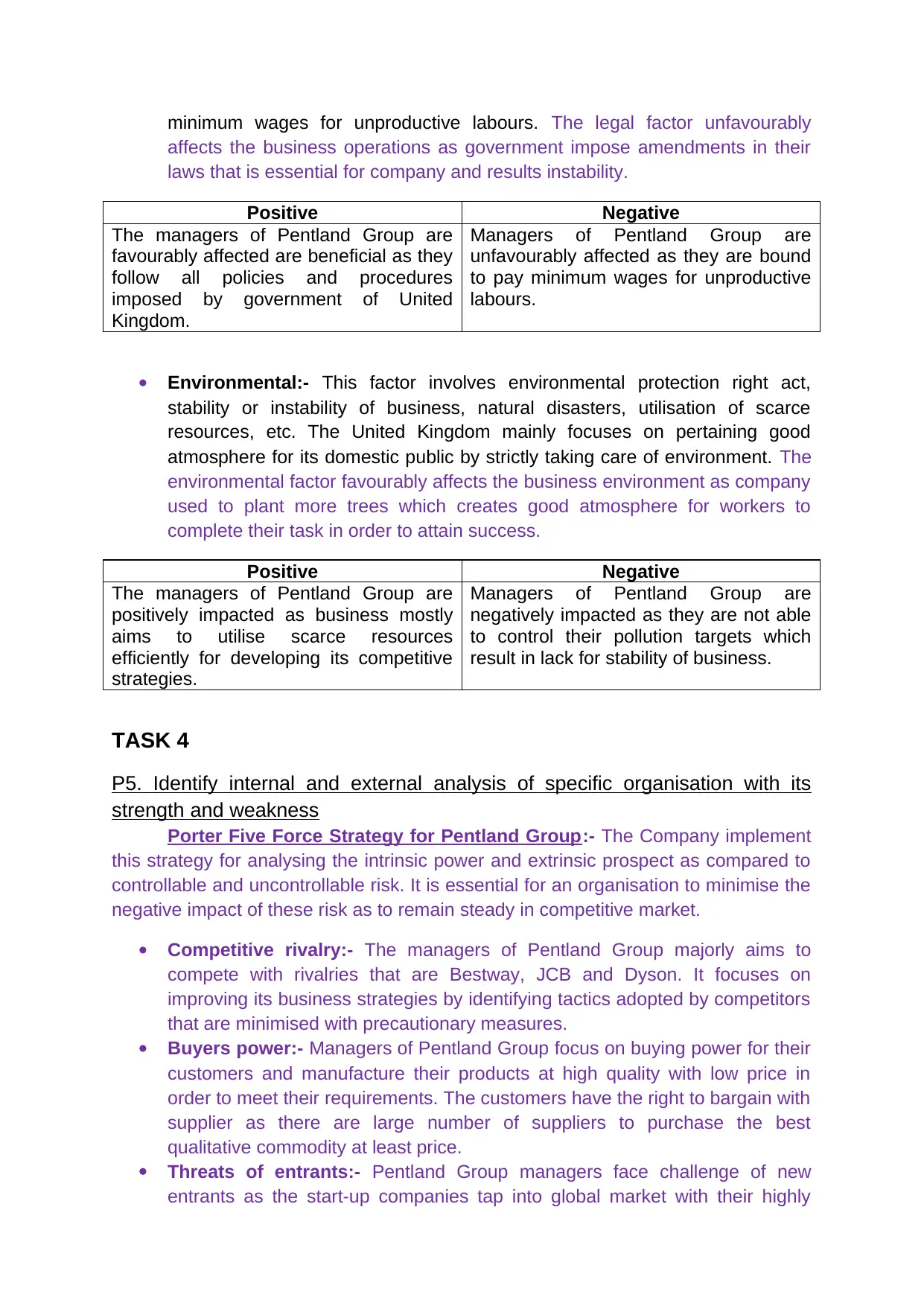
minimum wages for unproductive labours. The legal factor unfavourably
affects the business operations as government impose amendments in their
laws that is essential for company and results instability.
Positive Negative
The managers of Pentland Group are
favourably affected are beneficial as they
follow all policies and procedures
imposed by government of United
Kingdom.
Managers of Pentland Group are
unfavourably affected as they are bound
to pay minimum wages for unproductive
labours.
Environmental:- This factor involves environmental protection right act,
stability or instability of business, natural disasters, utilisation of scarce
resources, etc. The United Kingdom mainly focuses on pertaining good
atmosphere for its domestic public by strictly taking care of environment. The
environmental factor favourably affects the business environment as company
used to plant more trees which creates good atmosphere for workers to
complete their task in order to attain success.
Positive Negative
The managers of Pentland Group are
positively impacted as business mostly
aims to utilise scarce resources
efficiently for developing its competitive
strategies.
Managers of Pentland Group are
negatively impacted as they are not able
to control their pollution targets which
result in lack for stability of business.
TASK 4
P5. Identify internal and external analysis of specific organisation with its
strength and weakness
Porter Five Force Strategy for Pentland Group:- The Company implement
this strategy for analysing the intrinsic power and extrinsic prospect as compared to
controllable and uncontrollable risk. It is essential for an organisation to minimise the
negative impact of these risk as to remain steady in competitive market.
Competitive rivalry:- The managers of Pentland Group majorly aims to
compete with rivalries that are Bestway, JCB and Dyson. It focuses on
improving its business strategies by identifying tactics adopted by competitors
that are minimised with precautionary measures.
Buyers power:- Managers of Pentland Group focus on buying power for their
customers and manufacture their products at high quality with low price in
order to meet their requirements. The customers have the right to bargain with
supplier as there are large number of suppliers to purchase the best
qualitative commodity at least price.
Threats of entrants:- Pentland Group managers face challenge of new
entrants as the start-up companies tap into global market with their highly
affects the business operations as government impose amendments in their
laws that is essential for company and results instability.
Positive Negative
The managers of Pentland Group are
favourably affected are beneficial as they
follow all policies and procedures
imposed by government of United
Kingdom.
Managers of Pentland Group are
unfavourably affected as they are bound
to pay minimum wages for unproductive
labours.
Environmental:- This factor involves environmental protection right act,
stability or instability of business, natural disasters, utilisation of scarce
resources, etc. The United Kingdom mainly focuses on pertaining good
atmosphere for its domestic public by strictly taking care of environment. The
environmental factor favourably affects the business environment as company
used to plant more trees which creates good atmosphere for workers to
complete their task in order to attain success.
Positive Negative
The managers of Pentland Group are
positively impacted as business mostly
aims to utilise scarce resources
efficiently for developing its competitive
strategies.
Managers of Pentland Group are
negatively impacted as they are not able
to control their pollution targets which
result in lack for stability of business.
TASK 4
P5. Identify internal and external analysis of specific organisation with its
strength and weakness
Porter Five Force Strategy for Pentland Group:- The Company implement
this strategy for analysing the intrinsic power and extrinsic prospect as compared to
controllable and uncontrollable risk. It is essential for an organisation to minimise the
negative impact of these risk as to remain steady in competitive market.
Competitive rivalry:- The managers of Pentland Group majorly aims to
compete with rivalries that are Bestway, JCB and Dyson. It focuses on
improving its business strategies by identifying tactics adopted by competitors
that are minimised with precautionary measures.
Buyers power:- Managers of Pentland Group focus on buying power for their
customers and manufacture their products at high quality with low price in
order to meet their requirements. The customers have the right to bargain with
supplier as there are large number of suppliers to purchase the best
qualitative commodity at least price.
Threats of entrants:- Pentland Group managers face challenge of new
entrants as the start-up companies tap into global market with their highly

specialised and distinctive products. This restricts the customer loyalty and
tends to purchase goods at low cost in order to achieve success efficiently.
Suppliers power:- The managers of Pentland Group have power to maintain
their pricing strategy in comparison with other suppliers available at
international market. It is the tactics imposed by managers to keep their
competitive price for competing with rivalries.
Threats of substitutes:- Managers of Pentland Group further analyse the
alternative that produces similar goods and services in order to develop
instability for company. It is most important for managers to determine the
strategies adopted by them for creating varied approaches that impose threat
for them.
SWOT Analysis:- This framework is used as a tool by managers of company
for analysing their intrinsic and extrinsic capabilities as compared with competitors.
Managers of Pentland Group implement this analysis for developing their competitive
strategies as to sustain in global market by competing with its rivalries that are
Bestway, JCB and Dyson (Savrul, Incekara and Sener, 2014).
The SWOT Analysis for managers of Pentland Group is shown as
under:-
Strength (S) Weakness (W)
The strength for managers of
Pentland Group is that they
develop customer relationship
management which results in high
support and loyalty.
Diversity among its workforce
results in accomplishment of
vision and mission efficiently that
increase its strength to minimise
weakness.
The Pentland Group lose
efficiency due to poor inventory
management practices.
The managers of Pentland Group
are adversely affected as their
innovative idea for product
development is not able to meet
the requirements of target market.
Opportunities (O) Threats (T)
The growth in population by high
birth rate increases the demand
for youngsters.
Rise in customer disposable
income leads buyers to purchase
more on their hobbies for playing
skills as to consume sports
products.
Rise in inflation rate tends to
decrease the demand of
customers that result in low sales
and less profit margins.
The managers of Pentland Group
face challenge for large number of
its competitors within perfect
competition market.
P6. Elaborate the interrelation of strength and weakness towards external
macro-factors
The interrelation of strength and weakness towards external macro-factors
are mentioned as under:-
Macro-environment factors Strength (S) Weakness (W)
tends to purchase goods at low cost in order to achieve success efficiently.
Suppliers power:- The managers of Pentland Group have power to maintain
their pricing strategy in comparison with other suppliers available at
international market. It is the tactics imposed by managers to keep their
competitive price for competing with rivalries.
Threats of substitutes:- Managers of Pentland Group further analyse the
alternative that produces similar goods and services in order to develop
instability for company. It is most important for managers to determine the
strategies adopted by them for creating varied approaches that impose threat
for them.
SWOT Analysis:- This framework is used as a tool by managers of company
for analysing their intrinsic and extrinsic capabilities as compared with competitors.
Managers of Pentland Group implement this analysis for developing their competitive
strategies as to sustain in global market by competing with its rivalries that are
Bestway, JCB and Dyson (Savrul, Incekara and Sener, 2014).
The SWOT Analysis for managers of Pentland Group is shown as
under:-
Strength (S) Weakness (W)
The strength for managers of
Pentland Group is that they
develop customer relationship
management which results in high
support and loyalty.
Diversity among its workforce
results in accomplishment of
vision and mission efficiently that
increase its strength to minimise
weakness.
The Pentland Group lose
efficiency due to poor inventory
management practices.
The managers of Pentland Group
are adversely affected as their
innovative idea for product
development is not able to meet
the requirements of target market.
Opportunities (O) Threats (T)
The growth in population by high
birth rate increases the demand
for youngsters.
Rise in customer disposable
income leads buyers to purchase
more on their hobbies for playing
skills as to consume sports
products.
Rise in inflation rate tends to
decrease the demand of
customers that result in low sales
and less profit margins.
The managers of Pentland Group
face challenge for large number of
its competitors within perfect
competition market.
P6. Elaborate the interrelation of strength and weakness towards external
macro-factors
The interrelation of strength and weakness towards external macro-factors
are mentioned as under:-
Macro-environment factors Strength (S) Weakness (W)
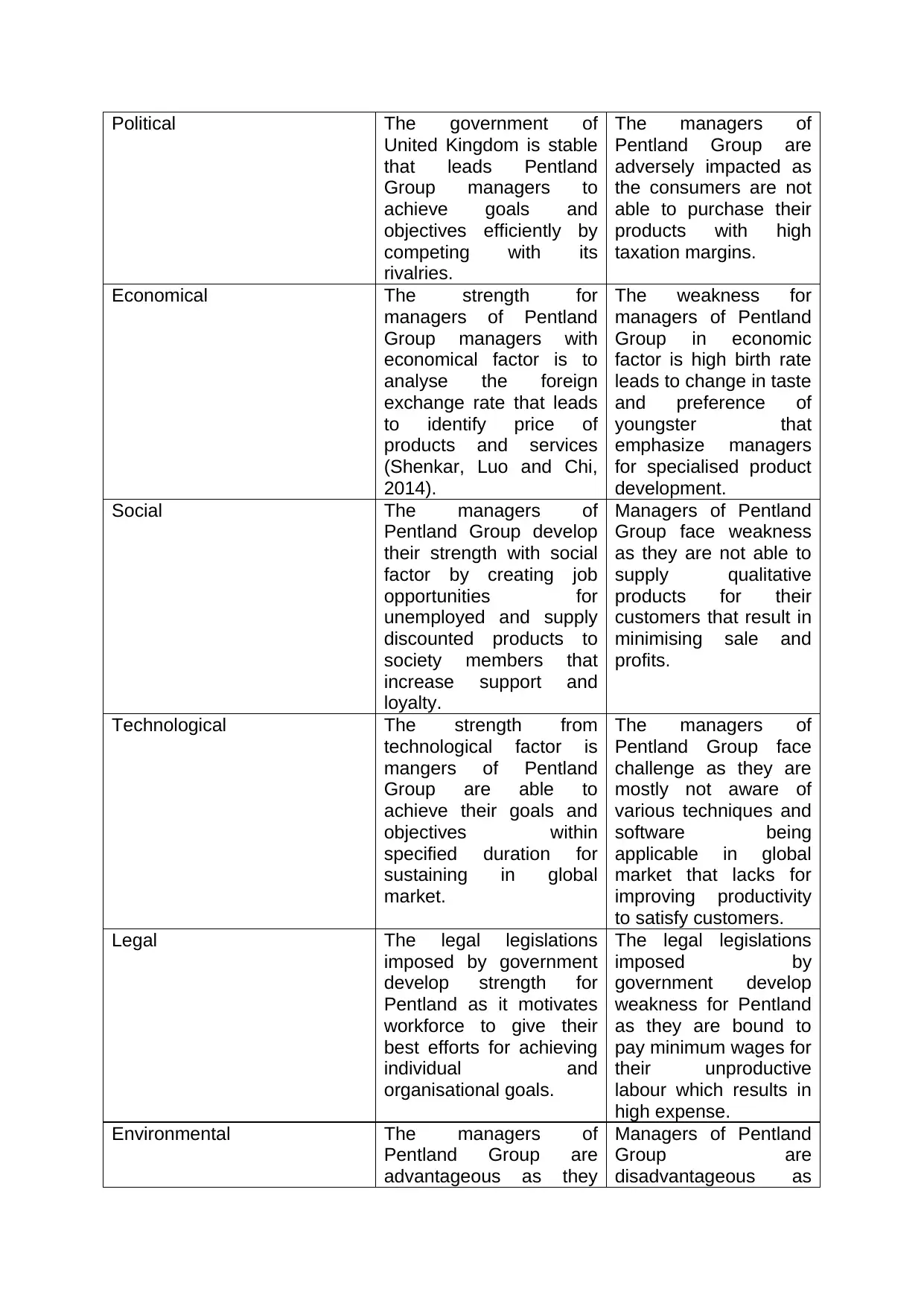
Political The government of
United Kingdom is stable
that leads Pentland
Group managers to
achieve goals and
objectives efficiently by
competing with its
rivalries.
The managers of
Pentland Group are
adversely impacted as
the consumers are not
able to purchase their
products with high
taxation margins.
Economical The strength for
managers of Pentland
Group managers with
economical factor is to
analyse the foreign
exchange rate that leads
to identify price of
products and services
(Shenkar, Luo and Chi,
2014).
The weakness for
managers of Pentland
Group in economic
factor is high birth rate
leads to change in taste
and preference of
youngster that
emphasize managers
for specialised product
development.
Social The managers of
Pentland Group develop
their strength with social
factor by creating job
opportunities for
unemployed and supply
discounted products to
society members that
increase support and
loyalty.
Managers of Pentland
Group face weakness
as they are not able to
supply qualitative
products for their
customers that result in
minimising sale and
profits.
Technological The strength from
technological factor is
mangers of Pentland
Group are able to
achieve their goals and
objectives within
specified duration for
sustaining in global
market.
The managers of
Pentland Group face
challenge as they are
mostly not aware of
various techniques and
software being
applicable in global
market that lacks for
improving productivity
to satisfy customers.
Legal The legal legislations
imposed by government
develop strength for
Pentland as it motivates
workforce to give their
best efforts for achieving
individual and
organisational goals.
The legal legislations
imposed by
government develop
weakness for Pentland
as they are bound to
pay minimum wages for
their unproductive
labour which results in
high expense.
Environmental The managers of
Pentland Group are
advantageous as they
Managers of Pentland
Group are
disadvantageous as
United Kingdom is stable
that leads Pentland
Group managers to
achieve goals and
objectives efficiently by
competing with its
rivalries.
The managers of
Pentland Group are
adversely impacted as
the consumers are not
able to purchase their
products with high
taxation margins.
Economical The strength for
managers of Pentland
Group managers with
economical factor is to
analyse the foreign
exchange rate that leads
to identify price of
products and services
(Shenkar, Luo and Chi,
2014).
The weakness for
managers of Pentland
Group in economic
factor is high birth rate
leads to change in taste
and preference of
youngster that
emphasize managers
for specialised product
development.
Social The managers of
Pentland Group develop
their strength with social
factor by creating job
opportunities for
unemployed and supply
discounted products to
society members that
increase support and
loyalty.
Managers of Pentland
Group face weakness
as they are not able to
supply qualitative
products for their
customers that result in
minimising sale and
profits.
Technological The strength from
technological factor is
mangers of Pentland
Group are able to
achieve their goals and
objectives within
specified duration for
sustaining in global
market.
The managers of
Pentland Group face
challenge as they are
mostly not aware of
various techniques and
software being
applicable in global
market that lacks for
improving productivity
to satisfy customers.
Legal The legal legislations
imposed by government
develop strength for
Pentland as it motivates
workforce to give their
best efforts for achieving
individual and
organisational goals.
The legal legislations
imposed by
government develop
weakness for Pentland
as they are bound to
pay minimum wages for
their unproductive
labour which results in
high expense.
Environmental The managers of
Pentland Group are
advantageous as they
Managers of Pentland
Group are
disadvantageous as
Paraphrase This Document
Need a fresh take? Get an instant paraphrase of this document with our AI Paraphraser
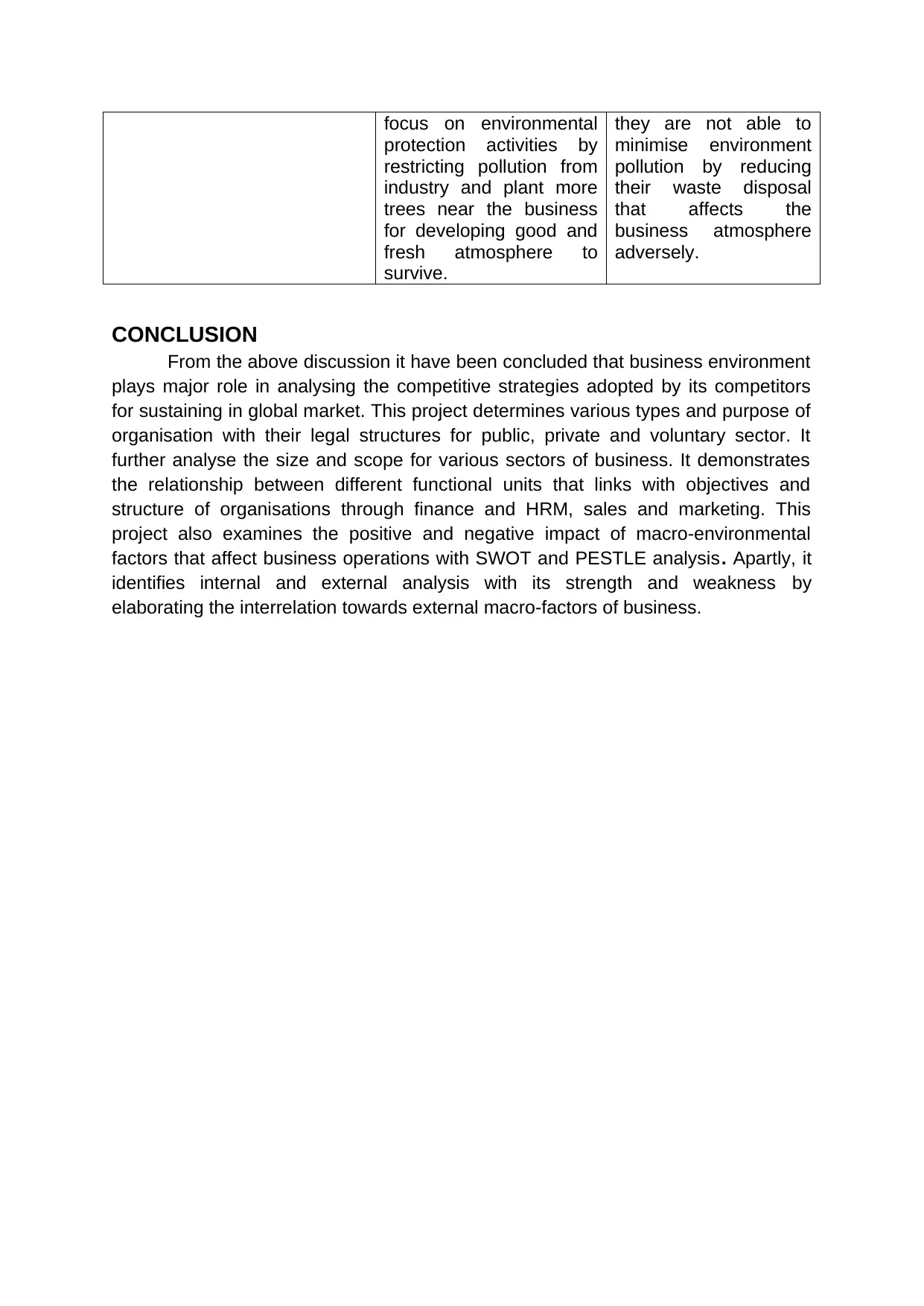
focus on environmental
protection activities by
restricting pollution from
industry and plant more
trees near the business
for developing good and
fresh atmosphere to
survive.
they are not able to
minimise environment
pollution by reducing
their waste disposal
that affects the
business atmosphere
adversely.
CONCLUSION
From the above discussion it have been concluded that business environment
plays major role in analysing the competitive strategies adopted by its competitors
for sustaining in global market. This project determines various types and purpose of
organisation with their legal structures for public, private and voluntary sector. It
further analyse the size and scope for various sectors of business. It demonstrates
the relationship between different functional units that links with objectives and
structure of organisations through finance and HRM, sales and marketing. This
project also examines the positive and negative impact of macro-environmental
factors that affect business operations with SWOT and PESTLE analysis. Apartly, it
identifies internal and external analysis with its strength and weakness by
elaborating the interrelation towards external macro-factors of business.
protection activities by
restricting pollution from
industry and plant more
trees near the business
for developing good and
fresh atmosphere to
survive.
they are not able to
minimise environment
pollution by reducing
their waste disposal
that affects the
business atmosphere
adversely.
CONCLUSION
From the above discussion it have been concluded that business environment
plays major role in analysing the competitive strategies adopted by its competitors
for sustaining in global market. This project determines various types and purpose of
organisation with their legal structures for public, private and voluntary sector. It
further analyse the size and scope for various sectors of business. It demonstrates
the relationship between different functional units that links with objectives and
structure of organisations through finance and HRM, sales and marketing. This
project also examines the positive and negative impact of macro-environmental
factors that affect business operations with SWOT and PESTLE analysis. Apartly, it
identifies internal and external analysis with its strength and weakness by
elaborating the interrelation towards external macro-factors of business.
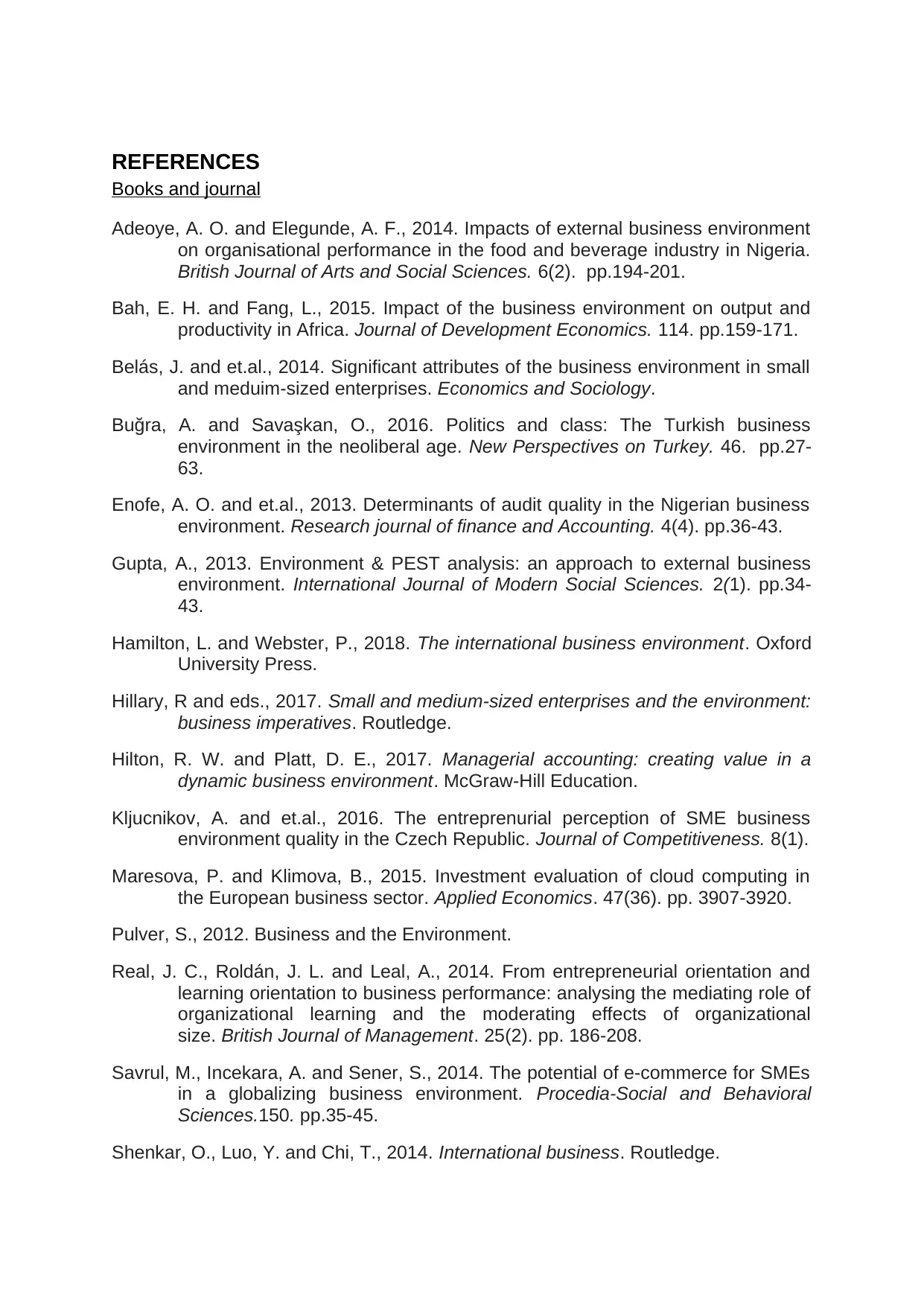
REFERENCES
Books and journal
Adeoye, A. O. and Elegunde, A. F., 2014. Impacts of external business environment
on organisational performance in the food and beverage industry in Nigeria.
British Journal of Arts and Social Sciences. 6(2). pp.194-201.
Bah, E. H. and Fang, L., 2015. Impact of the business environment on output and
productivity in Africa. Journal of Development Economics. 114. pp.159-171.
Belás, J. and et.al., 2014. Significant attributes of the business environment in small
and meduim-sized enterprises. Economics and Sociology.
Buğra, A. and Savaşkan, O., 2016. Politics and class: The Turkish business
environment in the neoliberal age. New Perspectives on Turkey. 46. pp.27-
63.
Enofe, A. O. and et.al., 2013. Determinants of audit quality in the Nigerian business
environment. Research journal of finance and Accounting. 4(4). pp.36-43.
Gupta, A., 2013. Environment & PEST analysis: an approach to external business
environment. International Journal of Modern Social Sciences. 2(1). pp.34-
43.
Hamilton, L. and Webster, P., 2018. The international business environment. Oxford
University Press.
Hillary, R and eds., 2017. Small and medium-sized enterprises and the environment:
business imperatives. Routledge.
Hilton, R. W. and Platt, D. E., 2017. Managerial accounting: creating value in a
dynamic business environment. McGraw-Hill Education.
Kljucnikov, A. and et.al., 2016. The entreprenurial perception of SME business
environment quality in the Czech Republic. Journal of Competitiveness. 8(1).
Maresova, P. and Klimova, B., 2015. Investment evaluation of cloud computing in
the European business sector. Applied Economics. 47(36). pp. 3907-3920.
Pulver, S., 2012. Business and the Environment.
Real, J. C., Roldán, J. L. and Leal, A., 2014. From entrepreneurial orientation and
learning orientation to business performance: analysing the mediating role of
organizational learning and the moderating effects of organizational
size. British Journal of Management. 25(2). pp. 186-208.
Savrul, M., Incekara, A. and Sener, S., 2014. The potential of e-commerce for SMEs
in a globalizing business environment. Procedia-Social and Behavioral
Sciences.150. pp.35-45.
Shenkar, O., Luo, Y. and Chi, T., 2014. International business. Routledge.
Books and journal
Adeoye, A. O. and Elegunde, A. F., 2014. Impacts of external business environment
on organisational performance in the food and beverage industry in Nigeria.
British Journal of Arts and Social Sciences. 6(2). pp.194-201.
Bah, E. H. and Fang, L., 2015. Impact of the business environment on output and
productivity in Africa. Journal of Development Economics. 114. pp.159-171.
Belás, J. and et.al., 2014. Significant attributes of the business environment in small
and meduim-sized enterprises. Economics and Sociology.
Buğra, A. and Savaşkan, O., 2016. Politics and class: The Turkish business
environment in the neoliberal age. New Perspectives on Turkey. 46. pp.27-
63.
Enofe, A. O. and et.al., 2013. Determinants of audit quality in the Nigerian business
environment. Research journal of finance and Accounting. 4(4). pp.36-43.
Gupta, A., 2013. Environment & PEST analysis: an approach to external business
environment. International Journal of Modern Social Sciences. 2(1). pp.34-
43.
Hamilton, L. and Webster, P., 2018. The international business environment. Oxford
University Press.
Hillary, R and eds., 2017. Small and medium-sized enterprises and the environment:
business imperatives. Routledge.
Hilton, R. W. and Platt, D. E., 2017. Managerial accounting: creating value in a
dynamic business environment. McGraw-Hill Education.
Kljucnikov, A. and et.al., 2016. The entreprenurial perception of SME business
environment quality in the Czech Republic. Journal of Competitiveness. 8(1).
Maresova, P. and Klimova, B., 2015. Investment evaluation of cloud computing in
the European business sector. Applied Economics. 47(36). pp. 3907-3920.
Pulver, S., 2012. Business and the Environment.
Real, J. C., Roldán, J. L. and Leal, A., 2014. From entrepreneurial orientation and
learning orientation to business performance: analysing the mediating role of
organizational learning and the moderating effects of organizational
size. British Journal of Management. 25(2). pp. 186-208.
Savrul, M., Incekara, A. and Sener, S., 2014. The potential of e-commerce for SMEs
in a globalizing business environment. Procedia-Social and Behavioral
Sciences.150. pp.35-45.
Shenkar, O., Luo, Y. and Chi, T., 2014. International business. Routledge.
1 out of 15
Related Documents
Your All-in-One AI-Powered Toolkit for Academic Success.
+13062052269
info@desklib.com
Available 24*7 on WhatsApp / Email
![[object Object]](/_next/static/media/star-bottom.7253800d.svg)
Unlock your academic potential
© 2024 | Zucol Services PVT LTD | All rights reserved.





